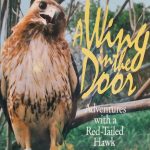Living with Merak, sometimes I have thought that it may be that all the world now is human-imprinted, that is, fixated on humankind’s tawdry intimations of what a world might be. And I do grieve for that. Our imprint now is almost universal.
After eleven years with her, it is undeniably apparent to us that Merak’s particular web of being is irrevocably damaged. Although most springs she flies out to greet and soar with a passing male red-tail–sometimes for several days–to the best of out knowledge, union never takes place. Each year, she lavishes weeks on her straggly porch-roof nest of sticks, lays her infertile eggs, tens them, and reaps nothing. By now, we know that it is highly unlikely that she will form that lifelong bond with another hawk, or bring new life to add to the skies.
And it is hard not to see a similar kind of damage in a world where people everywhere speak to me in anguish of beloved rivers that run with poison and of soil that withers. My sometime fear is that the links are already broken in too many ways. The words will barely write themselves on this page, but could it be that the earth is beyond healing?
But always and forever, there is more than one way of seeing. We cannot know what may come to pass. And perhaps learning to live appreciatively with the realities of uncertainty has been Merak’s greatest gift to me.
The lessons of living without sure answers offer rich rewards. Since Merak’s deviation from normal hawk behavior exclude her from the final privileges of hawkdome–making and rearing young–there can be no denying that she is damaged. But having said this, I need to add that unexpected benefits have come from these very exclusions.
One of these is that, while Merak seemed to mature to the end of her limits after her early years, she continues to learn and to change. Each year, she finds new and often surprising strategies to expand her possibilities. Also, because she has been afforded the luxury of extended leisure, security and ease, I wonder whether it can be said that she has pushed the very limits of hawk behavior. She has given me insight into possibilities often denied to wild birds.
I had come to my relationship with her assuming that birds of prey were unlikely to be affectionate. Furthermore, because I was hoping to release her from her human bonding, for a number of years I tried to avoid showing my love to her. And yet, after a while, I started noticing how, if we were away for a week, she showed up promptly to greet us on our return. Although she was always well-fed by staff or friends in our absence, it was clear she had missed us and was pleased when we returned. Even if just one of us was gone, she made it plain that she was happier on that one’s return. Years after Jeremy disappeared when he left home for university, she is sure to hang around on his rare visits. And only he can be sure of coaxing her up onto his wrist these days.
Of course, it might be argued that what she misses is no more than security. But eventually, when I had given up hope of complete independence for her, I let down my guard. It was then that I discovered how she leans blissfully into my stroking hand and croons to me, how she sometimes grooms my hair with her beak and how she takes pleasure in my company if I sit by her while she splashes in her pool. Now I know that she is as hungry for affection as any creature I have known, and I only regret that I did not start responding sooner.
Another aspect of her life which may have resulted from her unusual ease, is her sense of play. Freed from the responsibilities of raising fledglings, she has relished games of chase in which she and the dogs alternate as pursuer, or she rushes at window-basking cats, who, delightfully titillated, swear at her from behind the dubious safety of a screen. If no one is available, she gleefully tosses and pounces on sticks for herself, or feints and jabs at the garden hose.
It even appears to me that she may enjoy creativity. Every summer, long after the nesting urge should be ended, from time to time she returns briefly to her nest. As I watch, she putters, adding a few more twigs, stepping back along the roof to admire the artistry of what (to me) still appears to be a messy pile of sticks.
In the end, what I want to say to you is that through the gift of this pitiably damaged, yet magnificent hawk I have learned that the lessons of openness in the face of unknowing are available to all of us. What worlds there are in what remains.
